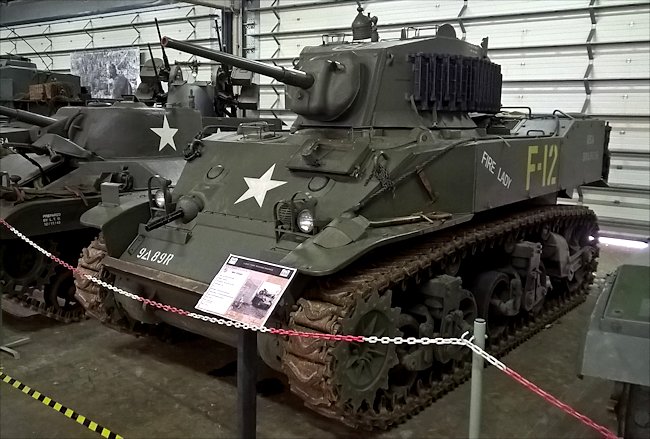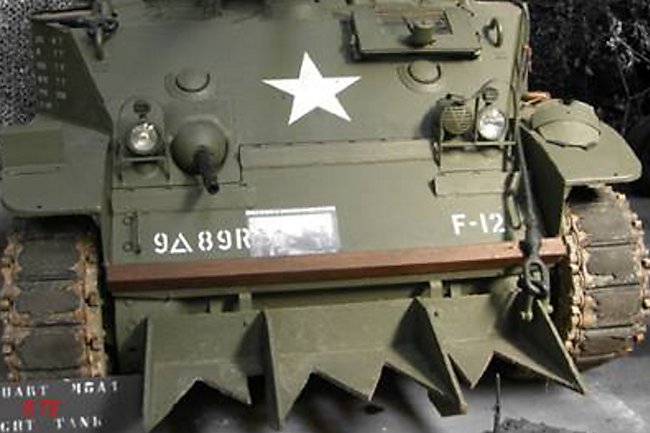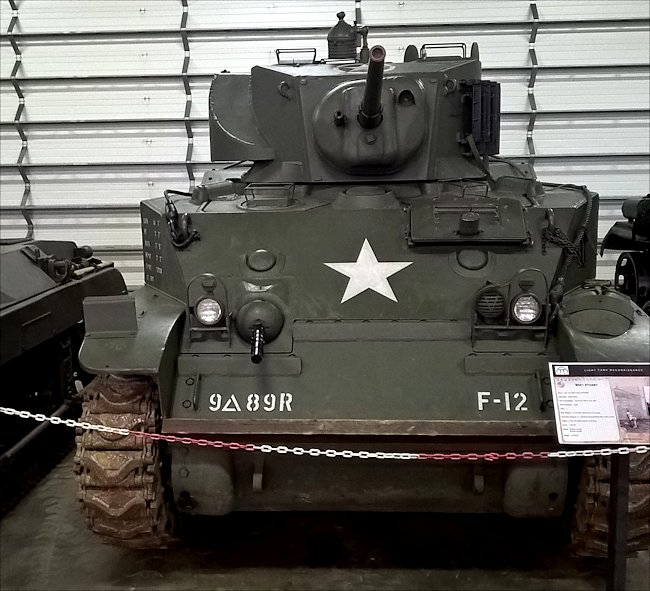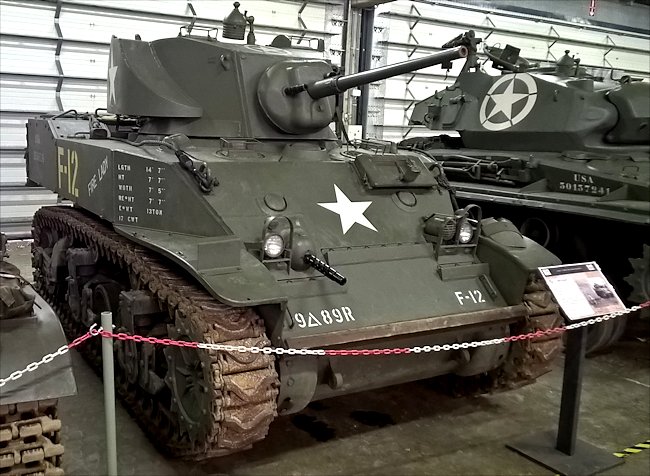M5A1 Stuart Light Tank
M5A1 Stuart Light Tanks saw action in the WW2 Battle of the Bulge. This surviving tank is kept at the Bastogne Barracks in Belgium.

This restored M5A1 Stuart Light Tank is exhibited at the Bastogne Barracks in Belgium.
Location
The Bastogne Barracks can be found at 40 Rue de la Roche (N834) in Bastogne just north west of the city centre. They open at 10am and close at 4pm. You really need to get there by 2pm as there is a lot to see. It is an operational military camp with a tank restoration centre attached. You have to wait to go on a guided tour. You cannot wander around on your own. The only day it is closed is Monday. Many of the tanks have been restored to running condition. Have a look at their Facebook page for information about new events.
Belgium Army Stuart tanks
The Belgian Army were given ten Stuart tanks after World War Two finished in 1945. They were used to train the new Belgium Army tank crews how to drive and fight with modern tracked armoured vehicles. This was one of them. During the restoration of the vehicle the name 'Fire Lady' was uncovered on the sides of the tank. It was restored by the late Adjudant Danny Vandenbussche at the Belgium Army Kapellen Workshop. When it closed this M5A1 was sent to Bastogne Barracks. Originally it was fitted with a hedge cutting dozer blade.

M5A1 Stuart Light Tank fitted with a hedge cutting dozer blade. It is a replica of the original 'Cullins Device' used to enable tanks to push through field boundary hedges. It was fabricated by Adjudant Danny Vandenbussche.
What was the Stuart used for?
The M5A1 Stuart was used as a forward patrol tank as a reconnaissance vehicle with the ability to call in artillery support and heavier armour. It was fast and could normally get out of trouble by making a quick exit. It could engage infantry, soft skinned and lightly armoured targets but not heavily armoured tanks like the German Panther or Tiger. It was armed with a 37 mm M6 cannon and three 30-06 Browning M1919A4 machine guns: one in the hull, one coaxial next to the main turret gun and the third on top of the turret roof for anti-aircraft protection.
It was powered by twin V8 Cadillac series 42 engines that produced 220 bhp. It had a top speed on the road of 58 km/h (36 mph) and 29 km/h (18 mph) off road. It weighed 16.5 tons in a battle ready fully loaded condition. Its armour ranged form 13 mm to 51 mm in thickness. The M5A1 version of the Stuart tank differed from the previous models by having an extended longer turret which provided more room for a more powerful radio. It is believed 6,810 were produced. It was the main US army light tank in operational service after 1943.

This Preserved M5A1 Stuart Light Tank has spare track links attached to the turret to provide extra protection.
US advance towards Bastogne in the snow
Here is a 712th Battalion Tank Crew member's account of their advance towards the Bulge. 'As we drove north through Luxembourg toward Bastogne on the 9th January 1945,. The weather was horrendous: A blizzard made driving difficult and hazardous, and tanks chugged along slower than one could walk. Going uphill at night was an ordeal beyond comprehension. You had to be there to experience it. It was impossible for the driver to see the road. He was driving without lights and what he did see was nothing but white in front, to the left and to the right.'
'Wind-blown snow slapped at his face, making it necessary for him to press the bridge of his nose against the hatch rim and have his helmet pulled down to his eyebrows. His field of vision was reduced to a one- inch slit and was guided by a fluorescent reflector attached to the back of the helmet of one of his crew members who was walking in the left track impression made in the snow by the tank in front.'
'A slip off the road to one side could plunge the tank into a ravine; to the other side, into a ditch, which would make it impossible to get back onto the road unless the tank were backed down to where ditch and road were on the same level.'
'Needless to say, my tank slipped into the ditch. My crew and I had to wait until the convoy passed, then back down and start the hellish climb over again. It took more than two hours for us to reach the top of the hill. When we got there, we stood alone. The rest of the 712th had disappeared.'

This surviving M5A1 Stuart Light Tank does not have a machine gun on top of the turret but does have one in the hull and coaxial next to the main gun in the turret.
Ice and Tanks January 1945
Another US tank crew's account of the drive to Bastogne in January 1945. 'When we moved from Dillingen up through Luxembourg I was so tired. We had been driving for a long time racing to get to Bastogne. I didn't have an assistant tank driver and I was getting sleepy. One time I hit an icy spot in the road and I sat on the edge of a cliff, and the tank rocking and going over and just started laughing, 'We're just about ready to go over the cliff.'
'I didn't know how steep the cliff was. It could have been just a ditch or it could have been a mountain, I just remember that I sat on the edge and the tank was rocking, Whether it was far enough out that if you had put a 50-pound weight on the gun it would have gone over I couldn't say. A guy came up behind me and hooked his tank on and pulled me back.'
'Another time I hit an icy spot and damn near went through a building. And then we pulled the tank back and we helped other tanks. That was cold that night and the road was icy and it was snowing. We had rubber pads on our light tanks and rubber on ice skidded. But through the efforts of our damn good drivers, we got darn near everything through.'
M5A1 Stuart Light tanks and HE
'The tank had taken a hit, right in the side, a large high explosive shell. And as I recall, it ripped the weld open on the tank and gave everybody inside a terrible blow, but nobody was seriously hurt. They really got their bells rung: I wasn't very popular with them when I left that tank on that zeroed-in intersection. Dumb thing to do.'
German Infantry attack M5A1 Stuart tanks
'We were guarding the flank near Wiltz in Luxemburg. That night we had a firefight. I heard tanks moving and I said, 'I can hear the medium tanks, I guess they're leaving.' All of a sudden I saw a flame go up. I said, 'There's a tank on fire.' I said, 'Shit, they hit one of our tanks.' In fact I was wrong it was one of their tanks that got knocked out but I did not know that at the time. So I'm looking out and I see somebody run across in front of the tanks, a silhouette, and I looked again.
The Germans had a different helmet. There was something about the hook or something on the helmet that got my eye and I said to my tank commander, 'Albee! Albee! I think those are Germans running across the flaming tank." He got his binoculars out and in the meantime I got my turret turned facing right at that tank. He said, 'Yes, they are.' So we started shooting. I was firing the machine gun and the cannon, and he's firing the machine gun on top.
The Germans went between us and the tank. They had advanced in two columns and the old German captain out there was hollering in English, 'For God's sake, stop firing. You're killing your own men. Don't shoot! We're Americans!' Then Albee got his binoculars again and said, 'No, they're Heinies.' Now Americans don't fire white tracer. They were firing white tracer. So we continued firing on them. And then later on they gave up and came in. I forget how many we captured and how many we killed, but this was a German captain that could speak English that we got. If I remember right, I think we killed twenty that night.'
US Tanks capture German Troops near Wiltz
'The 4th Armored Division drove a corridor up into Bastogne to help relieve Bastogne, but they were having a lot of trouble widening that corridor, so we were ordered to attack astride a road that came into Bastogne. We were astride that road and over here, this was sort of a high finger of ground. Then down in the valley you could see Wiltz in the distance. So we were attacking astride this road, got out of town, and Germans were falling out from the bushes right under our feet. We didn't even know they were there and surrendering. Most of them were Volkssturm troops: old men and young boys. Poor guys, you had to feel sorry for them.'
Read more in these two tank books

